Punjab State Board PSEB 8th Class Maths Book Solutions Chapter 15 Introduction to Graphs Ex 15.3 Textbook Exercise Questions and Answers.
PSEB Solutions for Class 8 Maths Chapter 15 Introduction to Graphs Ex 15.3
1. Draw the graphs for the following tables of values, with suitable scales on the axes.
Question (a)
Cost of apples
| Number of apples | 1 | 2 | 3 | 4 | 5 |
| Cost (in ₹) | 5 | 10 | 15 | 20 | 25 |
Solution:
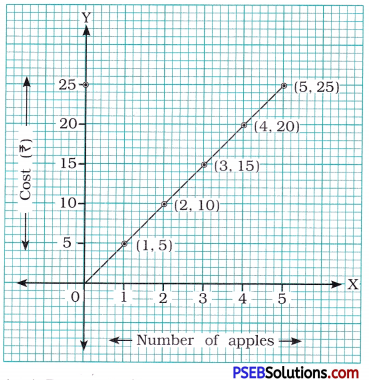
1. Draw 2 lines perpendicular to each other as X-axis and Y-axis on graph paper.
2. Take scale :
On X-axis : 1 cm = 1 apple
On Y-axis 1 cm = ₹ 5
3. Plot the points (1, 5), (2, 10), (3, 15), (4, 20) and (5, 25) on graph paper.
4. Join these points and extend line.
![]()
(b) Distance travelled by a car
| Time (in hours) | 6 a.m. | 7 a.m. | 8 a.m. | 9 a.m. |
| Distance (in km) | 40 | 80 | 120 | 160 |
Solution:
1. Draw two lines perpendicular to each other as X-axis and Y-axis on graph paper.
2. Take scale:
On X-axis : 2 cm = 1 unit (Time in hours.)
On Y-axis : 1 cm = 10 km
3. Plot the points (6, 40), (7, 80), (8, 120) and (9, 160) on graph paper.
4. Join these points and extend line.
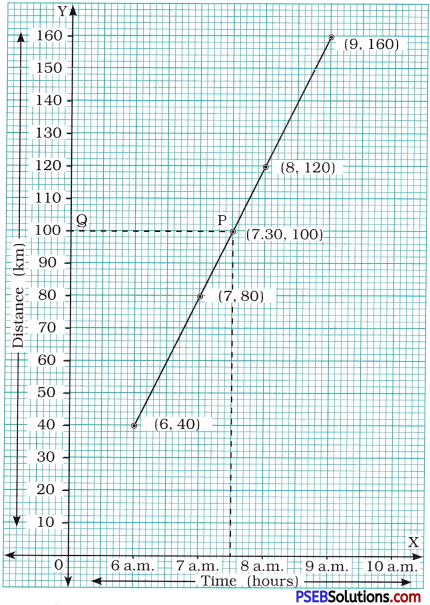
Question (i)
How much distance did the car cover during the period 7:30 a.m. to 8:00 a.m.?
Solution:
In the graph, draw a perpendicular at the point indicating 7:30 a.m. on the X-axis such that it meets the graph at P.
From P draw a line parallel to X-axis to meet Y-axis at 100 km.
∴ Distance travelled between 7:30 am and 8:00 am.
= (120 – 100) km
= 20 km
![]()
Question (ii)
What was the time when the car had covered a distance of 100 km since it’s start?
Solution:
When the car had covered a distance of 100 km, the time was 7 : 30 am.
(c) Interest on deposits for a year.
| Deposit (in ₹) | 1000 | 2000 | 3000 | 4000 | 5000 |
| Simple Interest (in ₹) | 80 | 160 | 240 | 320 | 400 |
Solution :
1. Draw two lines perpendicular to each other as X-axis and Y-axis on graph paper.
2. Take scale:
On X-axis : 2 cm = ₹ 1000 (deposit)
On Y-axis : 1 cm = ₹ 40 (simple interest)
3. Plot the points (1000, 80), (2000, 160), (3000, 240), (4000, 320) and (5000, 400) on graph paper.
4. Join these points and extend line.
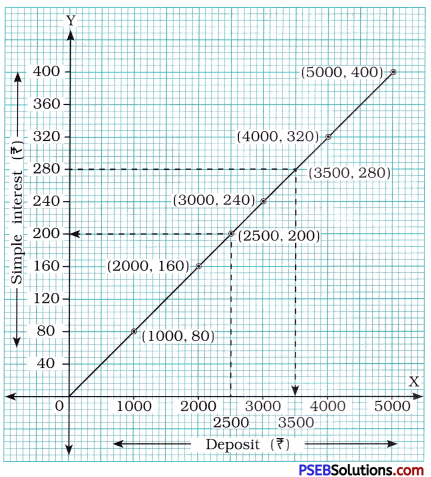
Question (i)
Does the graph pass through the origin?
Solution:
Yes, it passes through the origin.
![]()
Question (ii)
Use the graph to find the interest on ₹ 2500 for a year.
Solution:
From the graph, the interest on ₹ 2500 for a year is ₹ 200.
Question (iii)
To get an interest of ₹ 280 per year, how much money should be deposited?
Solution:
From the graph an interest of ₹ 280 can be got by depositing ₹ 3500.
2. Draw a graph for the following:
Question (i)
| Side of square (in cm) | 2 | 3 | 3.5 | 5 | 6 |
| Perimeter (in cm) | 8 | 12 | 14 | 20 | 24 |
Is it a linear graph?
Solution:
1. Draw two lines perpendicular to each other as X-axis and Y-axis on graph paper.
2. Take scale:
On X-axis : 1 cm = 1 cm (Side of a square)
On Y-axis : 1 cm = 4 cm (Perimeter of a square) )
3. Plot the points (2, 8), (3, 12), (3.5, 14), (5, 20) and (6, 24) on graph paper.
4. Join these points and extend line.
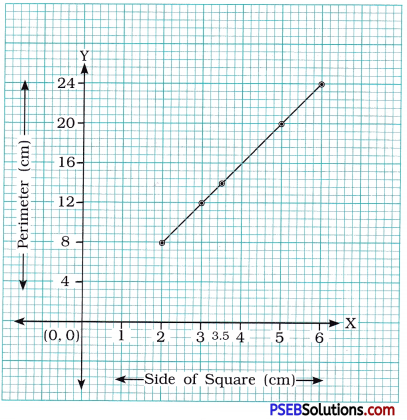
Yes, it is a linear graph.
![]()
Question (ii)
| Side of square (in cm) | 2 | 3 | 4 | 5 | 6 |
| Area (in cm2) | 4 | 9 | 16 | 25 | 36 |
Is it a linear graph?
Solution:
1. Draw two lines perpendicular to each other as X-axis and Y-axis on graph paper.
2. Take scale:
On X-axis : 1 cm = 1 cm (Side of a square)
On Y-axis : 1 cm 5 cm (Area of a square)
3. Plot the points (2, 4), (3, 9), (4, 16), (5, 25) and (6, 36) on graph paper.
4. Join these points.
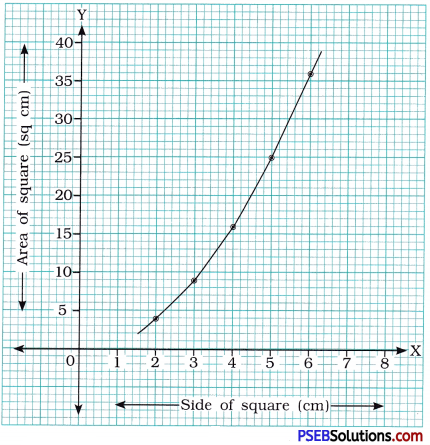
No, this graph is not a straight line. So it is not a linear graph.